Redox Study guides, Class notes & Summaries
Looking for the best study guides, study notes and summaries about Redox? On this page you'll find 1646 study documents about Redox.
Page 27 out of 1.646 results
Sort by
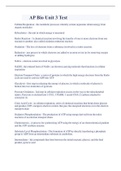
-
AP Bio Unit 3 Test latest updates
- Exam (elaborations) • 3 pages • 2023
-
Available in package deal
-
- $7.99
- + learn more
AP Bio Unit 3 Test Cellular Respiration - the metabolic processes whereby certain organisms obtain energy from organic moelcules Kilocalories - the unit in which energy is measured Redox Reaction - A chemical reaction involving the transfer of one or more electrons from one reactant to another; also called oxidation-reduction reaction. Oxidation - The loss of electrons from a substance involved in a redox reaction. Reduction - any process in which electrons are added to an atom or...

-
Campbell Biology Chapter 10 Test Bank
- Exam (elaborations) • 78 pages • 2023
-
Available in package deal
-
- $11.49
- + learn more
Skill: Application/Analysis Campbell's Biology, 9e (Reece et al.) Chapter 10 Photosynthesis Students find this chapter quite challenging. Fortunately, some of the key concepts, such as chemiosmosis and redox, were discussed previously in the chapter on respiration and fermentation. The new key concepts are light as energy, light absorption and energy conversion by pigments, and linear and cyclic electron flow. Students are challenged to identify the relationships between the light reac...
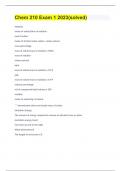
-
Chem 210 Exam 1 2023(solved)
- Exam (elaborations) • 7 pages • 2023
-
Available in package deal
-
- $16.99
- + learn more
Molarity moles of solute/liters of solution mole fraction moles of A/total moles solute + moles solvent mass percentage mass of solute/mass of solution x 100% mass of solution solute+solvent ppm mass of solute/mass of solution x 10^6 ppb mass of solute/mass of solution x 10^9 volume percentage vol of component/total volume x 100 molality moles of solute/kg of solvent ** denominator does not include mass of solute Ionization Energy The amount of...

-
Test Bank For Becker’s World of the Cell, 9th Edition Jeff HardinGreg Bertoni
- Exam (elaborations) • 483 pages • 2022
-
- $20.00
- 1x sold
- + learn more
Test Bank For Becker’s World of the Cell, 9th Edition Jeff HardinGreg Bertoni Chapter 2 The Chemistry of the Cell 2.1 Multiple-Choice Questions 1) What atom forms the backbone of almost all biological molecules? A) hydrogen B) nitrogen C) carbon D) sulfur E) phosphorus Answer: C Chapter Section: 2.1 Bloom's Taxonomy: Knowledge Learning Outcome: 2.1 Global LO: G7 2) Ribose has five carbon atoms, of which three are asymmetric. What is the maximum number of stereoiso...
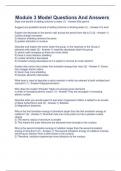
-
Module 3 Model Questions And Answers
- Exam (elaborations) • 4 pages • 2023
- Available in package deal
-
- $9.99
- + learn more
Module 3 Model Questions And Answers State one benefit of adding chlorine to water (1) - Answer-Kills germs Suggest one possible hazard of adding chlorine to drinking water (1) - Answer-It is toxic Explain the decrease in the atomic radii across the period from Na to Cl (3) - Answer-1) nuclear charge increases 2) electron shielding remains the same 3) greater attraction to nucleus Describe and explain the trend, down the group, in the reactivity of the Group 2 elements with water (5) -...
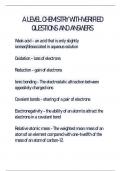
-
A LEVEL CHEMISTRY WITH VERIFIED QUESTIONS AND ANSWERS
- Exam (elaborations) • 9 pages • 2024
-
- $19.99
- + learn more
A LEVEL CHEMISTRY WITH VERIFIED QUESTIONS AND ANSWERS Weak acid - an acid that is only slightly ionised/dissociated in aqueous solution Oxidation - loss of electrons Reduction - gain of electrons Ionic bonding - The electrostatic attraction between oppositely charged ions Covalent bonds - sharing of a pair of electrons Electronegativity - the ability of an atom to attract the electrons in a covalent bond Relative atomic mass - The weighted mean mass of an atom of an element ...
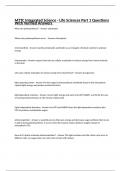
-
MTTC Integrated Science - Life Sciences Part 1 Questions With Verified Answers
- Exam (elaborations) • 16 pages • 2024
- Available in package deal
-
- $10.99
- + learn more
Who uses photosynthesis? - Answer autotrophs Where does photosynthesis occur? - Answer chloroplasts chemosyntheis - Answer used by prokaryotic autotrophs as an inorganic chemical reaction to produce energy heterotrophs - Answer require food and use cellular respiration to release energy from chemical bonds in the food who uses cellular respiration to release energy from stored food? - Answer all organisms light capturing events - Answer The first stage in photosynthesis; thylakoid...
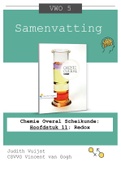
-
Samenvatting: Chemie Overal Scheikunde: Hoofdstuk 11; Redox (VWO 5)
- Summary • 3 pages • 2021
-
Available in package deal
-
- $3.28
- 3x sold
- + learn more
Samenvatting Chemie Overal 4e editie VWO 5 Hoofdstuk 11: Redox. In de samenvatting zijn de volgende paragrafen samengevat: 11.2 Reacties met elektronenoverdracht 11.3 Redoxkoppels 11.4 Redoxreacties in oplossing 11.5 Alcoholen als reductor *Paragraaf 11.1 is niet inbegrepen vanwege onbelangrijke informatie.* Alle begrippen zijn groen gekleurd in de samenvatting. Heb je vragen? Stuur mij gerust een berichtje zodat ik het kan ophelderen :). De samenvatting is in totaal 2 A4...
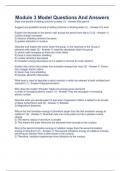
-
Module 3 Model Questions And Answers
- Exam (elaborations) • 4 pages • 2023
-
- $10.99
- + learn more
Module 3 Model Questions And Answers State one benefit of adding chlorine to water (1) - Answer-Kills germs Suggest one possible hazard of adding chlorine to drinking water (1) - Answer-It is toxic Explain the decrease in the atomic radii across the period from Na to Cl (3) - Answer-1) nuclear charge increases 2) electron shielding remains the same 3) greater attraction to nucleus Describe and explain the trend, down the group, in the reactivity of the Group 2 elements with water (5) -...
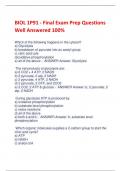
-
BIOL 1P91 - Final Exam Prep Questions Well Answered 100%
- Exam (elaborations) • 5 pages • 2023
-
- $12.49
- + learn more
BIOL 1P91 - Final Exam Prep Questions Well Answered 100% Which of the following happens in the cytosol? a) Glycolysis b) breakdown of pyruvate into an acetyl group c) citric acid cyle d)oxidative phosphorylation e) all of the above - ANSWER Answer: Glycolysis The net products of glycolysis are: a) 6 CO2 + 4 ATP, 2 NADH b) 2 pyruvate, 2 atp, 2 NADH c) 2 pyruvate, 4 ATP, 2 NADH d) 2 pyruvate, 2 GTP, and 2CO2 e) 2 CO2, 2 ATP & glucose - ANSWER Answer: b, 2 pyruvate, 2 atp, 2 NADH...
-
1
- ...
-
26
-
27
-
28
- ...

Do you wonder why so many students wear nice clothes, have money to spare and enjoy tons of free time? Well, they sell on Stuvia! Imagine your study notes being downloaded a dozen times for $15 each. Every. Single. Day. Discover all about earning on Stuvia


